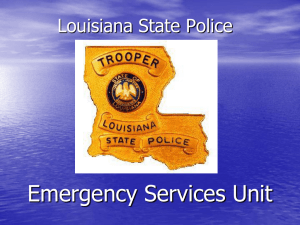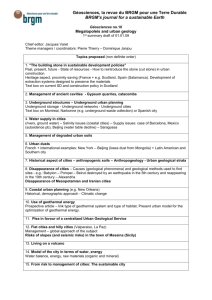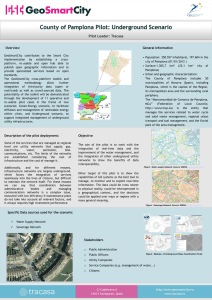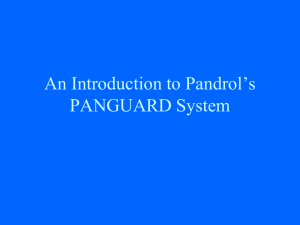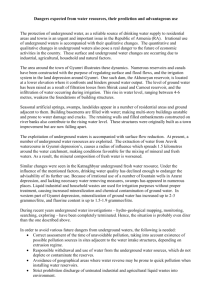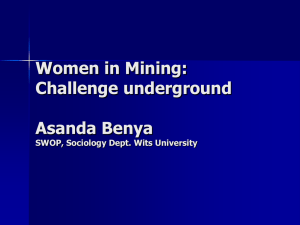File - Highways Safety Hub Campaign Resources 2015/16
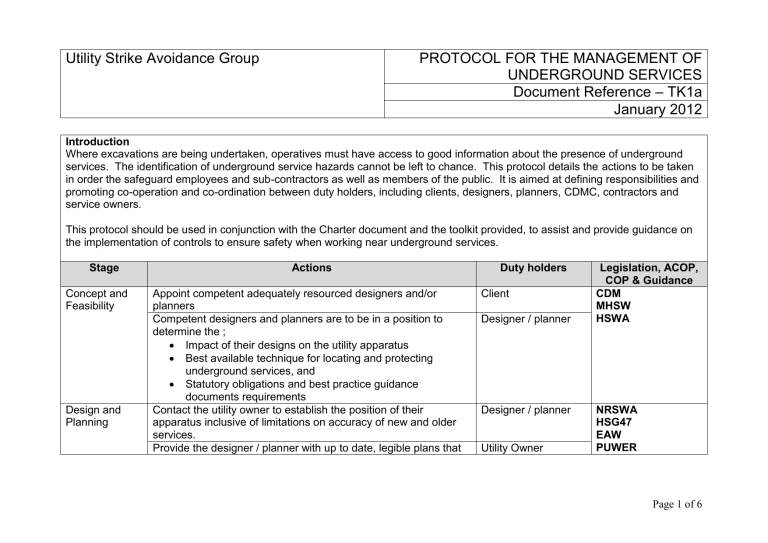
Utility Strike Avoidance Group PROTOCOL FOR THE MANAGEMENT OF
UNDERGROUND SERVICES
Document Reference
– TK1a
January 2012
Introduction
Where excavations are being undertaken, operatives must have access to good information about the presence of underground services. The identification of underground service hazards cannot be left to chance. This protocol details the actions to be taken in order the safeguard employees and sub-contractors as well as members of the public. It is aimed at defining responsibilities and promoting co-operation and co-ordination between duty holders, including clients, designers, planners, CDMC, contractors and service owners.
This protocol should be used in conjunction with the Charter document and the toolkit provided, to assist and provide guidance on the implementation of controls to ensure safety when working near underground services.
Stage
Concept and
Feasibility
Actions Duty holders Legislation, ACOP,
COP & Guidance
CDM
MHSW
HSWA
Design and
Planning
Appoint competent adequately resourced designers and/or planners
Competent designers and planners are to be in a position to determine the ;
Impact of their designs on the utility apparatus
Best available technique for locating and protecting underground services, and
Statutory obligations and best practice guidance documents requirements
Client
Designer / planner
Contact the utility owner to establish the position of their apparatus inclusive of limitations on accuracy of new and older
Designer / planner services.
Provide the designer / planner with up to date, legible plans that Utility Owner
NRSWA
HSG47
EAW
PUWER
Page 1 of 6
Utility Strike Avoidance Group
Tender
PROTOCOL FOR THE MANAGEMENT OF
UNDERGROUND SERVICES
Document Reference
– TK1a
January 2012 show;
Recorded location, configuration line and depth of known services in the specified areas
The extent and location of particularly vulnerable services, and
Any other suitable shared information that will achieve the same aim
Identify underground services, recognising the limitations on accuracy of information. Where there is limited information, special problems or the techniques dictate (e.g. trenchless technology) take appropriate steps to identify the location of underground services (if necessary by digging trial holes).
Attend site to give advice / assistance if after conducting site investigations the designer / planner cannot locate the services or discovers that they are embedded in concrete.
Prior to finalising the design / contract drawings, confirm that any potential impact on utility apparatus has been considered.
Provide the contractor with up to date, readable plans that are accurate and as relevant as possible, which show the;
Recorded location, configuration line and depth of known services in the specified areas
The extent and location of particularly vulnerable services, and
Any other suitable shared information that will achieve the same aim
Designer / planner / utility owner
Utilities
Designer / planner / utility owner
Client NRSWA
HSG47
CDM
PUWER
Page 2 of 6
Utility Strike Avoidance Group
Construction
PROTOCOL FOR THE MANAGEMENT OF
UNDERGROUND SERVICES
Document Reference
– TK1a
January 2012
Ensure that items are included in the contract documentation to allow the contractor to price for;
Work at, near to or with services
Any additional investigations, including, if necessary the digging of trial holes to establish exact locations of underground services prior to excavation.
Evaluate tender submissions to ensure that systems are in place to provide competent people and adequate resources for safe working at or near underground services, including service location training, digging and reinstating practices and the recording of services.
Check with utilities that the underground services information is current and is transferred onto working plans, including vulnerable supplies and relevant features (such as valve pits, manholes, boxes, warnings, cover depth and topography change).
Competent operatives and their managers/supervisors are to be in a position to:
Use, and maintain service detection equipment
Read and interpret plans, drawings, maps and guidance documents
Know safe digging techniques (including the selection and use of mobile plant)
Know how to mark out on site and record service information, and
Client
Client
Contractor
Contractor
NRSWA
HSWA
HSG47
MHSW
L144
CDM
Page 3 of 6
Utility Strike Avoidance Group
Construction
(cont.)
PROTOCOL FOR THE MANAGEMENT OF
UNDERGROUND SERVICES
Document Reference
– TK1a
January 2012
Implement first response and emergency response arrangements
NOTE: Competence level to be identified in method statement.
Method statements for working near underground services to include but not be limited to;
Description and location of the works
Roles and responsibilities (including supervision arrangements)
Sequence of work activities (including specific site rules and any restrictions)
Appropriate operational safety controls (including safe digging practices, resources and emergency response arrangements)
Competence level of named operatives and their supervisors/managers
Supervisors / managers and operatives to hold the appropriate
Streetworks certificates
Carry out additional investigation, which should include the digging of trial holes to establish exact locations of underground services prior to mechanical excavation.
Prior to finalising amendments to the design / contract drawings confirm that any potential impact on utility apparatus has been considered.
Attend site to give advice / assistance if after conducting site investigations the contractor cannot locate the service or
Contractor
NRSWA
CDM
MHSW
HSG47
Page 4 of 6
Utility Strike Avoidance Group PROTOCOL FOR THE MANAGEMENT OF
UNDERGROUND SERVICES
Document Reference
– TK1a
January 2012
Commisioning and Handover discovers that they are embedded in concrete.
Use cable and pipe detection equipment that has been maintained and calibrated in accordance with the manufacturers instructions.
Provide the client with details of locations, type, configuration, line and depth of any services located, altered or installed during construction.
Provide utilities with details of any ‘as laid’ services information or any services located or altered during construction, including any realignment of carriageway or changes to geometry / ground levels.
Update records with new locations, type, configuration, line and depth (including special provisions and warnings) or any services located or altered during construction.
Contractor
Client
Utilities
CDM
NRSWA
Notes
The CLIENT could be a developer, statutory authority, utility owner or other entity.
DESIGNERS include anyone who prepares designs for construction work, see CDM ACOP L144 for definition.
CONTRACTOR includes Principal Contractor and Sub-contractors.
‘Underground Services’ means all pipes, cables and equipment associated with electricity, gas, water, sewerage, telecommunications and any associated connections and apparatus.
This document does not cover overhead cables or trenchless technology. Seek further guidance.
Legislation, Codes of Practice and Guidance Further Supporting Evidence
Page 5 of 6
Utility Strike Avoidance Group
NRSWA
HSG47
PUWER
EAW
HSWA
CDM
L144
MHSW
PROTOCOL FOR THE MANAGEMENT OF
UNDERGROUND SERVICES
Document Reference
– TK1a
New Roads and Streetworks Act 1991
Avoidance of Danger from Underground Services
Provision and Use of Work Equipment Regulations
Electricity at Work Regulations
Health and Safety at Work Act 1974
Construction (Design and Management) Regulations
Managing Health and Safety in Construction ACOP
Management of Health and Safety at Work
Regulations
January 2012
CIRIA Document C604 – CDM – Guidance for Designers
NJUG
*
*
*
Page 6 of 6

